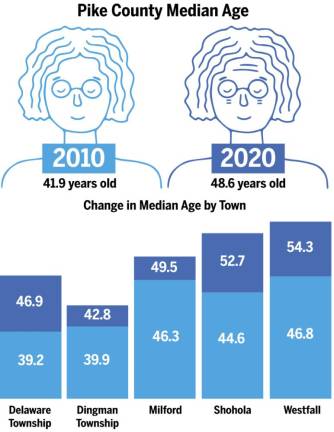How has Pike County changed over the past decade? A look at local census results
The Pike County Courier examined local census results in five neighboring towns: Milford, Dingman Township, Westfall, Delaware Township, and Shohola.

Incomes are growing, populations are changing, and residents are aging in Pike County. But out of all the towns examined for this story, Milford showed the least change between 2010 and 2020: the population barely budged, declined by just 7 people, the median household income grew by just 3%, and the population aged the least.
Growing Older
Pike County is aging – and has a surplus of senior living communities to back it up. County-wide, the median age is 48.6, up from 41.9 in 2010; a 16% increase.
“With that, there will be an increase in demand for services to support the senior community, whether that’s senior housing, public transportation, maybe Dial-A-Bus, or even paratransit to help seniors get around senior communities,” said Alan J. Sorensen, Orange County’s Planning Commissioner. “And of course, an increased demand for health services for the senior population.”
The state of Pennsylvania, meanwhile, is much younger. The state’s median age in 2020 is 40.9 – which grew just 2% over the decade from 40.2 in 2010.
Westfall and Milford, which both house a multitude of 55 plus communities, have the densest senior populations. 28.3% of Milford residents, and 30.7% of Westfall residents are 65 or older. Westfall boasts the highest median age at 54.3 years.
Dingman Township, meanwhile, has the lowest median age at 42.8. And while Delaware Township’s is below the county average at 46.9, the town aged the fastest between 2010 and 2020, growing 20% from39.2 in 2010.
Milford and Dingman Townships saw the slowest rate of aging at 7%.
Deeper Pockets
Of the towns examined, Dingman Township is the most affluent, sporting a median household income of $85,961. This wasn’t the case in 2010, however. When comparing 2010 household incomes for Milford, Dingman, Delaware, Westfall, and Shohola Townships, Milford’s was the highest at $79,327.
Over the decade incomes crawled in Milford, increasing just 3% to $85,563. Dingman Township, however, saw above-average growth, jumping 24% from its 2010 median household income of $69,239.
And while Dingman is the most affluent, Shohola saw the most growth over the decade. In Shohola, the median household income grew 33% from $52,950 to $70,200.
Population shifts
Overall, Pike County did not see significant population growth between 2010 and 2020; the overall population grew 2%, which is on par with the state average.
Of the towns examined, Milford is the only one that saw a decrease in population; the census estimates Milford lost 7 individuals, dipping from 1,530 in 2010 to 1,523 in 2020.
Delaware Township saw the slowest growth, increasing by just 0.8% over the decade. Westfall Township, meanwhile, saw its population increase by 9%.
Pike County’s Hispanic and Latino population increased 30% between 2010 and 2020, and now accounts for approximately 11% of the population. Shohola Township saw this the Hispanic and Latino population grow the fastest over the decade – increasing by 50%. Delaware and Westfall Townships also saw a significant increase, both growing 37%.
The Black and African American population, meanwhile, is down 1% county-wide. Of the towns examined, the most significant drop can be seen in Delaware Township, where the Black population decreased 27% from 214 people in 2010, to 169 in 2020. Dingman Township saw this population decrease by 4%.
Love in Pike County
Looking for love? In the towns The Pike County Courier looked at...
Delaware Township has the highest percentage of singles: 29.6% of adults never married.
Perhaps ironically, Delaware Township also has the second-highest divorce rate at 12%. Westfall’s is slightly higher at 12.6%.
Shohola’s in wedded bliss; 67.2% of adults are married, compared to the county average of 55.5%. You’re also least likely to be divorced in Shohola, where divorcees make up 5.8% of the population, compared to the county average of 10.6%.

